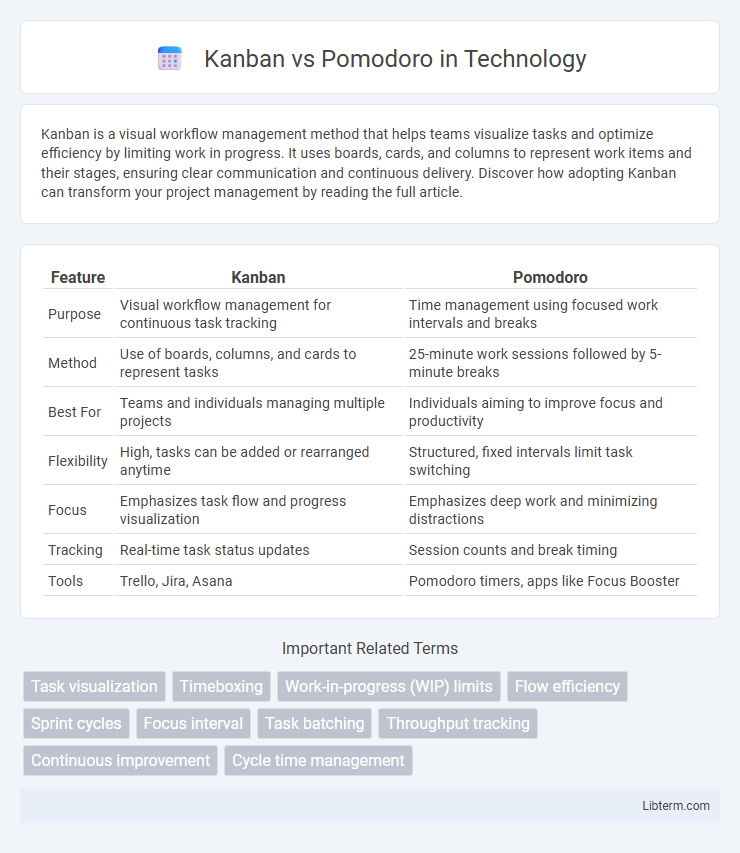Kanban is a visual workflow management method that helps teams visualize tasks and optimize efficiency by limiting work in progress. It uses boards, cards, and columns to represent work items and their stages, ensuring clear communication and continuous delivery. Discover how adopting Kanban can transform your project management by reading the full article.
Table of Comparison
| Feature | Kanban | Pomodoro |
|---|---|---|
| Purpose | Visual workflow management for continuous task tracking | Time management using focused work intervals and breaks |
| Method | Use of boards, columns, and cards to represent tasks | 25-minute work sessions followed by 5-minute breaks |
| Best For | Teams and individuals managing multiple projects | Individuals aiming to improve focus and productivity |
| Flexibility | High, tasks can be added or rearranged anytime | Structured, fixed intervals limit task switching |
| Focus | Emphasizes task flow and progress visualization | Emphasizes deep work and minimizing distractions |
| Tracking | Real-time task status updates | Session counts and break timing |
| Tools | Trello, Jira, Asana | Pomodoro timers, apps like Focus Booster |
Introduction to Kanban and Pomodoro
Kanban is a visual workflow management method that uses boards, columns, and cards to represent tasks and track progress, enhancing team collaboration and efficiency. The Pomodoro Technique divides work into focused intervals of 25 minutes, separated by short breaks, to boost concentration and reduce mental fatigue. Both methodologies improve productivity by promoting task organization and time management through distinct but complementary approaches.
Core Principles of Kanban
Kanban centers on visualizing work through a board divided into columns representing stages of a workflow, enabling continuous delivery and limiting work in progress to improve focus and efficiency. Key principles include managing flow by tracking tasks, setting explicit policies for task movement, and using feedback loops to enhance processes. These core elements help teams identify bottlenecks, balance workload, and maintain steady productivity without rigid time constraints inherent in methods like Pomodoro.
Key Concepts of the Pomodoro Technique
The Pomodoro Technique centers around time management by breaking work into focused intervals called "Pomodoros," typically lasting 25 minutes, followed by short breaks to enhance concentration and prevent burnout. This method emphasizes eliminating distractions during each Pomodoro and tracking completed intervals to improve productivity and work rhythm. Key concepts include time-boxing, regular breaks, and continuous progress monitoring to maintain sustained focus and reduce mental fatigue.
Kanban: Pros and Cons
Kanban offers visual task management through boards and cards, enhancing workflow transparency and enabling real-time adjustments to prioritize work efficiently. Its flexibility supports continuous improvement by highlighting bottlenecks, but it may lack strict time constraints, potentially leading to procrastination. Teams benefit from Kanban's adaptability across various project sizes, though it requires discipline to maintain updated boards and avoid task overload.
Pomodoro: Pros and Cons
Pomodoro technique enhances focus by breaking work into 25-minute intervals, improving productivity and reducing burnout. It promotes frequent breaks, which help maintain mental clarity but may disrupt deep work flow. However, Pomodoro can be rigid for tasks requiring extended concentration, making it less flexible compared to Kanban's visual task management approach.
Workflow Management: Kanban vs Pomodoro
Kanban optimizes workflow management by visually organizing tasks on boards, allowing teams to track progress and limit work in progress for enhanced efficiency. Pomodoro improves individual workflow by dividing work into focused intervals, boosting concentration and reducing burnout risk. Combining Kanban's task visualization with Pomodoro's timed sessions maximizes productivity and maintains steady work momentum.
Time Management: A Comparative Analysis
Kanban enhances time management by visualizing workflow and limiting work in progress, which reduces multitasking and bottlenecks, thereby improving task prioritization and efficiency. Pomodoro employs time-boxed intervals, typically 25 minutes of focused work followed by short breaks, to combat procrastination and maintain high levels of concentration throughout tasks. Combining Kanban's task visualization with Pomodoro's structured focus cycles offers a balanced approach to optimizing productivity and managing time effectively.
Ideal Use Cases for Kanban and Pomodoro
Kanban excels in managing continuous workflows with visual task tracking, making it ideal for project management, software development, and team collaboration where prioritization and progress monitoring are crucial. Pomodoro is best suited for individual tasks requiring intense focus and time management, such as studying, writing, or coding, by breaking work into focused intervals with regular breaks to enhance productivity. Combining Kanban for overall task organization and Pomodoro for focused execution can maximize efficiency in both team and personal productivity scenarios.
Integrating Kanban and Pomodoro for Productivity
Integrating Kanban and Pomodoro systems enhances productivity by combining visual task management with focused work intervals, optimizing workflow and time allocation. Kanban boards enable clear task prioritization and progress tracking, while Pomodoro sessions enforce disciplined work periods followed by short breaks to maintain high concentration levels. This integration facilitates efficient task execution, reduces burnout, and ensures continuous momentum in completing projects.
Choosing the Right Method for You
Choosing the right productivity method depends on your work style and task nature; Kanban excels in visualizing workflow and managing multiple projects simultaneously, while Pomodoro enhances focus through timed intervals ideal for deep work or study sessions. Evaluate whether you benefit more from continuous progress tracking and flexibility, typical of Kanban boards, or structured breaks and time-boxed effort inherent in Pomodoro technique. Combining elements of both can also optimize efficiency by addressing different aspects of task management and concentration.
Kanban Infographic

 libterm.com
libterm.com